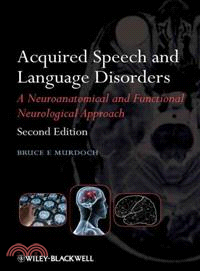| FindBook |
有 1 項符合
Acquired Speech and Language Disorders:A Neuroanatomical and Functional Neurological Approach的圖書 |
 |
Acquired Speech and Language Disorders:A Neuroanatomical and Functional Neurological Approach 作者:MURDOCH 出版社:JOHN WILEY & SONS 出版日期:2009-10-28 |
| 圖書館借閱 |
| 國家圖書館 | 全國圖書書目資訊網 | 國立公共資訊圖書館 | 電子書服務平台 | MetaCat 跨館整合查詢 |
| 臺北市立圖書館 | 新北市立圖書館 | 基隆市公共圖書館 | 桃園市立圖書館 | 新竹縣公共圖書館 |
| 苗栗縣立圖書館 | 臺中市立圖書館 | 彰化縣公共圖書館 | 南投縣文化局 | 雲林縣公共圖書館 |
| 嘉義縣圖書館 | 臺南市立圖書館 | 高雄市立圖書館 | 屏東縣公共圖書館 | 宜蘭縣公共圖書館 |
| 花蓮縣文化局 | 臺東縣文化處 |
|
|
- 圖書簡介
It is vital to have knowledge of the neuroanatomical structures and functional neurological mechanisms, which are disrupted in neurogenic speech/language, disordered persons in order to understand the speech/language deficits themselves.
This book provides a comprehensive coverage of the neurological basis of both the clinically recognised forms of aphasia and the various motor speech disorders, in both children and adults. It also covers more recently recognised language disorders, such as Parkinsons and related diseases, right hemisphere damage, closed-head injury, dementia, etc. This is a perfect text for practitioners who need to understand the integration of neuroanatomy and functional neurology with the practice of speech-language pathology. - 作者簡介
Professor Bruce E. Murdoch is the Director of the Centre for Neurogenic Communication Disorders Research and Head of the School of Health and Rehabilitation Sciences at the University of Queensland, Brisbane, Australia. He is the founding editor of the Asia Pacific Journal of Speech, Language and Hearing, the Foundation President of the Asia Pacific Society for the Study of Speech, Language and Hearing; and Vice-President of the International Association of Logopedics and Phoniatrics.
- 目次
1 Neuroanatomical and neuropathological framework of speech and language.
2 Aphasia syndromes.
3 Subcortical aphasia syndromes.
4 Speech-language disorders associated with traumatic brain injury.
5 Language disorders subsequent to right hemisphere lesions.
6 Language disturbances in dementia syndromes.
7 Language disorders associated with diseases of the cerebral white matter.
8 Neurological disturbances associated with aphasia.
9 Dysarthrias associated with upper and lower motor neurone lesions.
10 Dysarthrias associated with extrapyramidal syndromes.
11 Dysarthrias associated with lesions in other motor systems.
12 Acquired childhood speech-language disorders.
Index.
|











